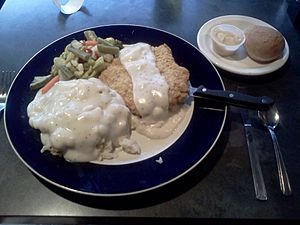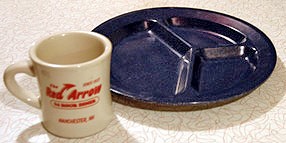Blue-plate special facts for kids

A blue-plate special is a term used in the United States and Canada. It refers to a meal offered at a restaurant, especially a diner or cafe. These meals are usually low-priced and change daily.
The term was very popular from the 1920s through the 1950s. Today, fewer restaurants offer blue-plate specials by that exact name. Sometimes, they even serve them on blue plates! Even though the tradition is fading, the phrase is still a common saying in America.
In the 1930s, a blue-plate special was described as "a low-priced daily diner special — a main course with all the fixings, a daily combo." It was a complete meal for a small price.
Contents
History of the Blue-Plate Special
The exact start of the phrase "blue-plate special" isn't fully clear. One idea is that during the Great Depression, a company started making plates with separate sections for different parts of a meal. These were like early versions of a TV dinner tray. For some reason, these divided plates were often only available in blue.
Another idea suggests that the blue plates were inexpensive. They often had a blue pattern, like the famous "blue willow" designs. Some records show the term was first used on a Fred Harvey Company restaurant menu in 1892. This suggests blue-plate specials were a regular feature at their restaurants.
The term became very common in the late 1920s. In 1926, an advertisement in The New York Times mentioned "Blue Plate Specials" at a restaurant. By 1928, an article talked about getting a "big blue-plate special, with meat course and three vegetables" for just a quarter. This was a great deal!
A common rule for blue-plate specials was "no substitutions." This meant you couldn't ask to swap out one food item for another. In a 1947 radio show, a person tried to change parts of his blue-plate special. The waiter politely explained that "no substitutions" meant you had to eat what was given.
The writer Graham Greene also mentioned this in his 1958 book Our Man in Havana. A character explained that with a blue-plate, "They shove the whole meal at you under your nose, already dished up on your plate." He added, "You eat what you're given. That's democracy, man."
Blue-Plate Specials Today

Today, a "blue-plate special" can mean any inexpensive, complete meal. It can also refer to a daily special, or just be a fun, old-fashioned way of saying something is a good deal.
In Events
The Boston Children's Museum has a play called Blue Plate Special. It teaches kids about good nutrition in a fun way.
The WDVX Blue Plate Special is a concert series in Knoxville, Tennessee. It's held almost daily during lunchtime at the Knoxville Visitor's Center. It's broadcast on the local radio station WDVX.
In Movies and TV
- In the 1973 film The Sting, Robert Redford's character orders the blue-plate special at a diner.
- In the 1997 movie Good Will Hunting, Matt Damon's character mentions a "blue plate special" during an important speech.
- On the TV show Double Dare, one challenge on the final obstacle course is called the "blue plate special."
In Books and Comics
- In the 1958 book Our Man in Havana by Graham Greene, the main character almost gets poisoned while eating a blue-plate lunch.
- In the Blondie comic strip from 1964, Dagwood wonders why the "blue plate special" is served on a white plate. The explanation is that it's named after the cook, Oscar Blueplate!
- Mystery writer Abigail Padgett wrote a novel called The Last Blue Plate Special (2001). In this story, the blue plates are part of the decoration at a clinic where patients are dying mysteriously.
See also
 In Spanish: Blue-plate special para niños
In Spanish: Blue-plate special para niños


